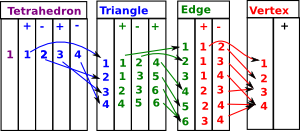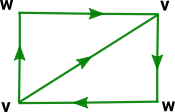(14) -> dhD := dunceHat()$DCF
(14)
2D:[[1,1,- 1]]
1D:[[1,- 1]]
0D:[[0]]
Type: DeltaComplex(Integer)
(15) -> dhS2 := dunceHat()$SCF
(15) points 1..8
(1,2,8)
(2,3,8)
(3,7,8)
(1,3,7)
(1,2,7)
(1,6,8)
(1,2,6)
(6,7,8)
(2,4,6)
(5,6,7)
(2,5,7)
(4,5,6)
(2,3,4)
(2,3,5)
(1,3,4)
(1,4,5)
(1,3,5)
Type: FiniteSimplicialComplex(Integer)
(16) -> dhD2 := deltaComplex(dhS2)
(16)
VCONCAT
VCONCAT
VCONCAT
,
2D:
[[1,- 5,11], [1,- 6,12], [1,- 7,13],
[2,- 3,14], [2,- 4,15],
[2,- 6,16], [3,- 4,18], [5,- 7,23],
[8,- 9,14], [8,- 10,15],
[8,- 13,17], [9,- 11,19],
[10,- 12,21], [16,- 17,24],
[18,- 19,20], [20,- 21,22], [22,- 23,24]]
,
1D:
[[1,- 2], [1,- 3], [1,- 4], [1,- 5],
[1,- 6], [1,- 7], [1,- 8],
[2,- 3], [2,- 4], [2,- 5], [2,- 6]
[2,- 7], [2,- 8], [3,- 4],
[3,- 5], [3,- 7], [3,- 8], [4,- 5]
[4,- 6], [5,- 6], [5,- 7],
[6,- 7], [6,- 8], [7,- 8]]
,
0D:[[0],[0],[0],[0],[0],[0],[0],[0]]
Type: DeltaComplex(Integer)
(17) -> dhS := simplicialComplexIfCan(dhD)
(17) "failed"
Type: Union("failed",...)
(18) -> dhS3 := simplicialComplexIfCan(dhD2)
(18) points 1..8
(1,2,6)
(1,2,7)
(1,2,8)
(1,3,4)
(1,3,5)
(1,3,7)
(1,4,5)
(1,6,8)
(2,3,4)
(2,3,5)
(2,3,8)
(2,4,6)
(2,5,7)
(3,7,8)
(4,5,6)
(5,6,7)
(6,7,8)
Type: Union(FiniteSimplicialComplex(Integer),...) |


 P²).
P²).